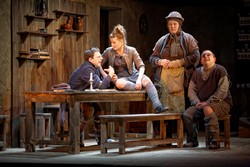Digital study methods to challenge standing narratives of Irish theatre history
The project LAPITH(opens in new window) (Locating and performing Irish theatre histories) examined historiographical approaches to and historical understandings of patterns of theatre development in 20th century Dublin. Work targeted construction of an integrated methodological blend of computer modelling, virtual worlds, performance film making and oral history. Enabling the digital study of theatre architecture should help further diversify research on early 20th century Irish theatre history. Project investigations focused on the architectural and social history of three Dublin theatres: Abbey Theatre (1904-1951), Queen's Theatre (1951-1969) and Theatre Royal (1935-1962). The aim was to intervene in Irish theatre history critically (by challenging the hegemony of the Abbey Theatre in accounts of early 20th-century Irish theatre history), historiographically (by foregrounding theatre architecture), and methodologically (by innovatively combining archival research, digital architectural modelling, film making and oral history). Efforts led to important new archival discoveries, including a previously unpublished photographic collection of the old Abbey Theatre, previously unknown architectural plans for the Queen's Theatre and original architectural blueprints for the Theatre Royal. Laurence Campbell's sculptures for the Theatre Royal were also located and captured three-dimensionally. LAPITH created detailed 3D digital models of the three theatres under study. In collaboration with an Irish small enterprise, these models will be brought into real-time environments for viewing on computer screens or through immersive 3D headsets. Other project successes include embedding the theory and practice of virtual heritage in masters-level programmes at Trinity College Dublin, a research collaboration with Dr Luiz Fernando Ramos, University of Saõ Paolo, and active participation in creating the Virtual Heritage Network: Ireland(opens in new window). LAPITH succeeded in embedding methodological expertise in the use of 3D modelling and virtual worlds in arts and humanities research. Project outcomes offer new approaches to historical studies, and help extend research on prevailing narratives of Irish theatre history as well as digital scholarly publishing. Invitations for keynote speeches and plenary papers evidence the interest of both subject specialists and wider academic audiences in the new methods and research agendas.







